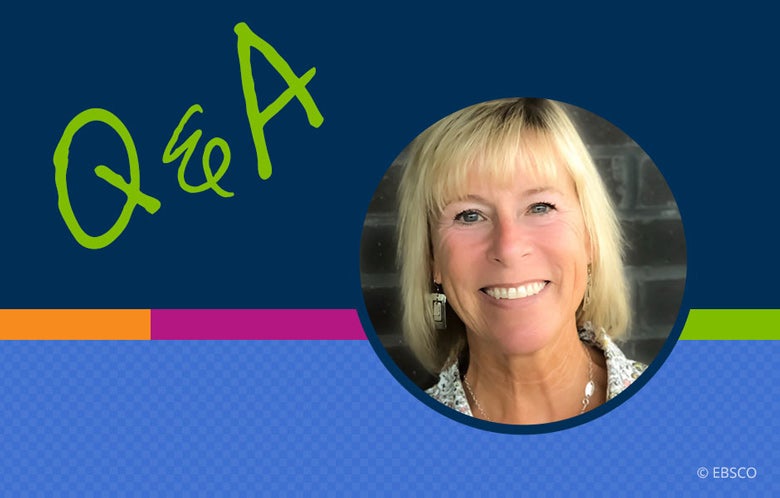Donna Shaw is a Director of Product Management at EBSCO. In her role, Donna works on products and solutions that focus on textbook affordability for students, interoperability with Learning Management Systems, bridging the communication gap between librarians and faculty, and providing insight to librarians and faculty on usage of resources and student engagement with resources. Her background and experience have influenced the development of EBSCO Faculty Select from idea to delivery. Learn how this product helps librarians and faculty support textbook affordability.
How long have you been in your role at EBSCO? What’s your background?
I’ve been at EBSCO just over two and a half years. I’ve been in Product Management for the better part of my career (more than 25 years) at large companies such as IBM and Microsoft, and smaller companies/startups where I was part of teams taking products from their first idea on a PowerPoint slide to their initial market release. I’ve worked on products/feature areas that saw great success, as well as ones that failed miserably. Let’s just say that I really learned a great deal from those failures!
Where did the idea for Faculty Select come from, and what customer problems does this new product address?
I can take no credit for the initial idea of a product designed to support faculty in finding affordable resources to use in their courses. The idea actually came from one of our early adopter customers, LOUIS, a consortium in Louisiana widely recognized as a model for cost-effective collaboration in higher education. LOUIS was looking for a way to make affordable resources discoverable by their institution’s faculty and the LOUIS team reached out to EBSCO for help with this endeavor. Thus, the idea was born to create a portal where faculty can search and discover OER (Open Educational Resources) and unlimited user access DRM-free e-books.
As far as the problems Faculty Select addresses, first and foremost, it’s about textbook affordability for students, as the costs continue to rise year over year. Secondly, it’s about providing faculty with a single location where they can search for and discover affordable e-books from quality OER providers and top academic publishers. This alleviates what has been a time-consuming and manual process for faculty as these resources live across a myriad of sites on the web. Finally, by facilitating the request and acquisition process through Faculty Select, librarians not only get insight into what course materials faculty are adopting, but it also drives value back to the usage of their library’s resources. It’s a win all around!
By creating a product that helps address challenges for faculty, we’re inevitably helping librarians and students as well.
Did you learn anything that surprised you during the development of Faculty Select?
As someone who’s been part of teams developing products for quite some time, there were no surprises during the development of Faculty Select. That said, there was something unexpected that I learned through conversations with librarians and reading through market reports/surveys on textbook affordability — there are sometimes communication challenges between librarians and faculty. Specifically, faculty are not always seeking out librarians for help in finding affordable resources. In some cases, they are not aware that librarians are willing to purchase them on their behalf. This contributes to the problem I mentioned above — librarians don’t always have insight into what course materials their faculty are adopting. As the daughter of a librarian, I saw the librarian as one of the most helpful resources one could seek out. I wasn’t aware that faculty don’t always engage librarians to get their help.
How does creating products/services that help faculty differ from creating products for librarians and students?
As a product manager, it’s my job to develop solutions that solve problems for particular personas. Faculty have a unique set of challenges that differ from the challenges of librarians and students. I mentioned the difficulty of finding quality Open Educational Resources and DRM-free e-books. Because this can be a time-consuming process, faculty may not be able to invest in finding these affordable resources and likely don’t seek out the librarian for help. While these problems are unique to faculty, there is a net effect on students and librarians. Students don’t get access to affordable resources and librarians can’t get a complete picture of the impact of library resources. By creating a product that helps address challenges for faculty, we’re inevitably helping librarians and students as well.
What’s next for Faculty Select?
Software is never done so there’s always something on the roadmap. For Faculty Select, we’d like to better support getting that insight to librarians by reporting on the titles faculty are adopting, for which courses, department, by whom and for which semester. Of course, it’s important that we continue to add content from quality Open Educational Resource providers as well as DRM-free e-books from top academic publishers. Recognizing that faculty and students are using the learning management system (LMS) as a key access point for creating and accessing course materials, providing interoperability with the LMS is also part of our direction. Of course, feedback from our customers is paramount to our success so we’ll see how people are using Faculty Select and look for input from our users to continue to provide a valuable solution.
